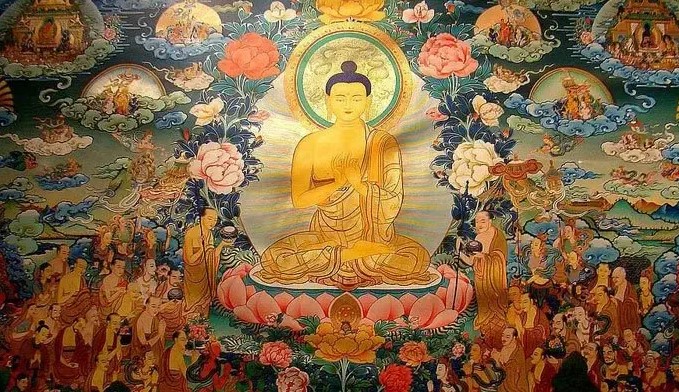Have you seen the huge paintings on silk while exploring Thamel and Basantapur? If you have not been to Nepal then you might have seen them on the internet. These magnificent works of art enchant not only art fanatics but locals too. In this blog, we shall take a closer look as to what these thangka paintings are and what they represent.
1. WHAT IS A THANGKA PAINTING?
Those huge paintings that you saw are called ‘Thangka’. In the Tibetan language, they are called Thangka whereas, in Nepal Bhasa, it is called Pauva. When we head deep into the Tibetan etymology, ‘Than’ means flat and ‘ka’ refers to painting. As you combine these words, you get the gist that thangka refers to a painting on a flat surface. They are used in monasteries and religious ceremonies.
2. BRIEF HISTORY
The remains of Tibetan paintings that date back to the 11th century were found in the Mogao caves in China. This cave was a library of primitive paintings, prints, manuscripts, and textiles. These paintings, although of Tibet origin, some argue that it reflects other art styles too. Thangka paintings on the cloth were seen in Tibet in the 11th century when Buddhism was reborn. Initially, the paintings were simple but later took on complex forms.
Through the centuries, thangka paintings began to witness rapid growth and incorporated various elements into it. In the 18th century, Such paintings were at its peak and they were painted not only in Tibet but countries like Mongolia, Nepal, and some parts of Russia.
3. PURPOSE OF THANGKA
Before paintings were used as a means of decoration, monks and travelers used it as a teaching device. They used the paintings to explain the life of Buddha along with other religious deities. They believed in the idea that through pictures, the message can travel easily. The most prevalent subject matter dealt in thangka is the ‘wheel of life’. It is a visual display of the Abhidharma teachings. Likewise, it goes by the art of enlightenment too.
4. TYPES
There are different types of thangka paintings depending upon the subject matter, technique, and materials used. In general, thangkas divide themselves in two groups. One of them includes painting while the other one takes the form of silk
Thangka paintings further fall under these categories:
- Red background
- Gold background
- Embroidery
- Block prints
- Black Background
- Applique
- Painted in colors
5. SIZE
While thangkas typically range from 20-50 centimeters, there are huge thangkas too which call the walls of monasteries home. These colossal paintings are more than a foot wide and the same can be said about their height too. Depending upon the need, the size of thangka paintings can vary.
6. WHAT IS A THANGKA PAINTING LIKE?
It occurs on either cotton or silk. A skilled craftsman spends more than 6 hours a day working on it. Depending upon the size and nature of the painting, it can take about a month or more. The most prevalent thangka paintings have numerous layers for support. The paint is water-soluble and both organic and mineral pigments come in use.
In terms of composition, it consists of the legs, arms, and the body of Buddha. There is more to Thangka painting that meets the eye. The painter must have a vivid imagination to bring his picture into life.
7. ELEMENTS OF THANGKA
The major theme in a thangka painting is Lord Buddha. The artist carefully uses four symbols to represent Lord Buddha. For instance, to explain the birth of Buddha, the artist uses a Sal tree and seven lotuses that look in four directions. Also, the artist places Buddha on a throne with the Bodhi tree emitting rays of light.
Another crucial element of the thangka painting is Buddha resting on an elongated bed throne. It sits between two Sal trees and represents the death of Buddha.
8. THANGKA PAINTING PROCESS
The painting process comprises of many techniques and details. We won’t fig deep in the details as it is lengthy so, we’ll give you a brief idea about it.
- Selecting an appropriate canvas
- Drawing the initial lining
- Sketching and coloring
- Outlining or using gold painting
- Drawing the face
9. SUMMARY
Thangka is one of the greatest gifts of mankind. It acts as a great teaching device and tool to remind us about the journey we should opt to become enlightened. The Trek Nepal can support you to find the place if you like to buy or want to learn the painting of Thangka.


Submit a Comment
You must be logged in to post a comment.